
10 Garden Bed Edging Ideas
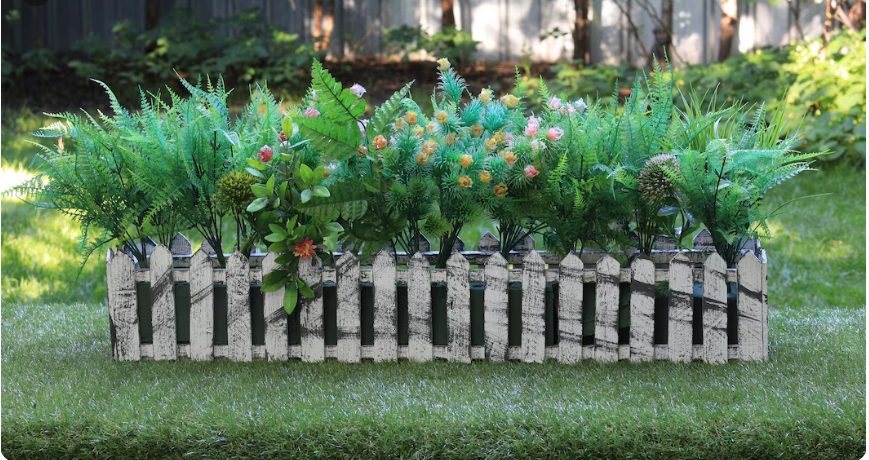
Garden beds stand out more with the right edging. A smart border keeps soil in place, separates paths from plants, and adds a polished look to your yard.
From natural stone to metal strips, there’s no shortage of ways to line your garden beds with style.
Some gardeners prefer simple lines, while others love a bit of flair. Materials like wood, brick, or recycled items offer both function and beauty.
Edging defines the space and makes garden care easier by blocking weeds and holding mulch.
Well-planned edges can tie the whole garden together. They highlight the shapes of your beds and give a clean finish to the design.
No matter the size of your space, creative edging brings out the best in your garden layout. These ten ideas will help you find the perfect fit for your style, your plants, and your outdoor goals.
10 Garden Bed Edging Ideas
Garden bed edging keeps your yard neat and adds style to your space. Edging stops grass from creeping into flower beds. It also gives structure to the garden.
A clean edge helps flowers stand out. Whether your style is rustic or modern, there’s an edging idea for you.
Below are 10 creative ideas to make your garden beds look fresh and well-planned. Each idea works for different styles, spaces, and budgets.
1. Brick Edging
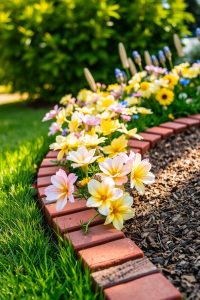
Bricks give a classic look to any garden. They work well in both formal and casual settings. Lay them flat for a smooth border or stand them upright for more texture.
Use red bricks for a warm tone or go with gray for a cooler look. Bricks stay in place for years. They don’t rot like wood or shift like loose stones.
Line them tightly to block weeds. For curved beds, angle them slightly to follow the shape.
2. Natural Stone Border
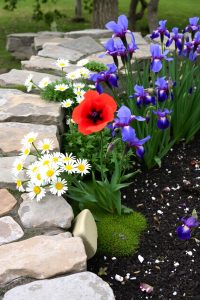
Natural stones create a relaxed, earthy look. Each stone has a different shape, so no two borders look the same. Pick stones from your area to match the environment.
This option blends well with flower gardens or vegetable beds. Stack the stones or lay them in a single layer. Leave small gaps for water to drain.
A mix of sizes gives a natural look, like a mountain trail or forest path.
3. Wood Plank Edging

Wood adds warmth and structure. Planks work great in straight lines. Use treated lumber or cedar to resist rot. Wooden edging looks clean and can match fences or raised beds.
Planks about 6 inches high create a strong edge. Secure them with wooden stakes. Stain or paint for a more finished look. For more height, stack two layers.
4. Metal Strip Edging

Metal strips give a clean and modern look. Use steel or aluminum for long-lasting edges. They hold sharp lines and won’t break or rot. This style works well in modern gardens.
Install strips flush with the ground for a hidden edge. Or let them rise slightly to create a barrier. Over time, steel may develop rust for a rustic look, while aluminum stays shiny.
5. Concrete Curbing

Concrete edging lasts a long time. It holds shape and resists weeds. You can pour it yourself or buy pre-made blocks. Curved and straight shapes are easy to create.
Concrete can be plain gray or colored to match your garden. Add texture with stamps or molds. This edging works great in large gardens or along pathways.
6. Log or Branch Edging
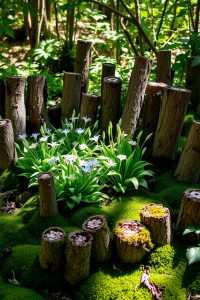
Logs and branches bring a woodland touch. Cut small logs and stand them upright side-by-side. Use branches for a woven look. This edging is perfect for cottage-style gardens.
Use hardwood to slow decay. Keep logs about 6–8 inches tall. Place them tightly for a stronger edge. This idea works best in shady or natural spaces.
7. Plastic Roll Edging

Plastic edging is simple and low-cost. It bends around curves and holds mulch in place. Pick heavy-duty plastic for better results.
Most plastic rolls come in black or brown. Install by digging a narrow trench and pressing the edging into place. Use stakes to keep it firm. This style suits simple gardens and clean lawns.
8. Stone Pavers
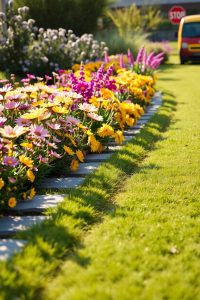
Pavers create a clean and tidy border. Unlike natural stones, pavers have even shapes. Use square or rectangular pavers for a structured look.
Lay them side-by-side or stand them up for height. You can create patterns with different colors or sizes. Pavers work well around flower beds, trees, or walkways.
9. Recycled Materials
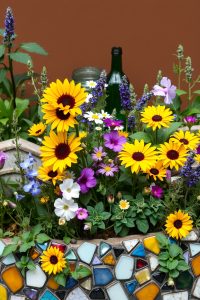
Old items can add charm to your garden. Use broken tiles, glass bottles, or clay pots. Line bottles neck-down or place pots on their sides. This idea fits well with playful, artsy gardens.
Mix colors and textures for a bold look. Keep safety in mind when working with glass or sharp edges. This edging is a great way to reuse what you already have.
10. Gabion Wall Edging
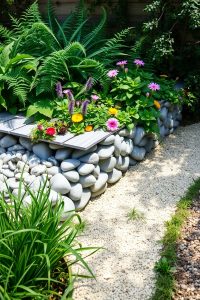
Gabions are wire cages filled with rocks. They create a strong, industrial-style border. You can use small cages for edging or taller ones for raised beds.
Fill gabions with river rocks, bricks, or recycled concrete. This method works well on slopes or where extra support is needed. It holds back soil and adds a bold touch.
FAQs
What is the best material for garden bed edging?
The best material depends on your garden style and climate. Brick, stone, and metal last longer. Wood and recycled items add charm but may need replacement sooner.
Does edging stop weeds?
Yes, strong edging can block grass and weeds from creeping into flower beds. It also keeps mulch in place.
Can I install edging by myself?
Most edging styles are easy to install with basic tools. Metal strips, wood planks, and plastic rolls are great for beginners.
How deep should garden edging go?
Most edges need to go 3–6 inches deep. This depth keeps them stable and blocks roots from spreading.
Do I need to dig before adding edging?
Yes, digging a small trench helps set the edge firmly. It keeps the border straight and stops it from moving.
Conclusion
Garden bed edging adds beauty and order to your yard. It helps flowers stand out and makes yard work easier. With so many styles available, there’s something for every garden.
Bricks, stones, wood, or metal—each brings a different look and feel. Try one of these edging ideas to frame your plants and give your garden a fresh finish. Keep it simple or make it bold. The choice is yours.
